How to Make Perfect Simit (Turkish Sesame Bread Rings)

Turkish Simit is a leavened dough ring covered with sesame seeds, typical of Turkey. It is a crispy crusted bun, characterized by a slightly sweetish flavor: it is usually eaten as a snack at any time of the day, often accompanied with sheep's cheese, olives and a cup of black tea for a fortifying snack, or with fruit jelly and jam for breakfast.
To make them, flour, water, yeast, sugar, extra virgin olive oil and salt are mixed together until a compact dough is obtained. After the leavening phase of about 2 hours, the dough is divided into six portions which, after a short resting time, are in turn shaped into loaves, folded into a U, braided and closed to form donuts. These are finally passed through a mixture of water and honey, covered with sesame and cooked first at 480°F/250 °C for 10 minutes, then at 390°F/200°C for a further 20.
The result is fragrant baked goods, soft inside, similar in consistency to German pretzels. They will be perfect to enjoy with both sweet and savory fillings: you can offer them in the bread basket for a family lunch or a convivial dinner with friends, offer them for a Sunday brunch or take them to school and the office for a satisfying break.
What is Turkish Simit?
Simit, often referred to as the "Turkish bagel," is a beloved bread with deep historical and cultural roots in Turkey and neighboring regions. Its origins date back to the Ottoman Empire, where it was a staple in Istanbul as early as the 16th century. Traditionally sold by street vendors carrying large trays on their heads, simit remains an iconic part of Turkish daily life, commonly enjoyed with tea for breakfast or as a snack throughout the day. The classic simit dough consists of flour, water, yeast, salt, and a touch of sugar, but its distinctive golden-brown crust comes from being dipped in a mixture of molasses and water before being generously coated with sesame seeds. Over time, regional variations have emerged—some versions incorporate sunflower or flax seeds, while others are slightly softer or crispier depending on local baking methods. Beyond Turkey, similar breads can be found in Greece (koulouri) and the Balkans, highlighting its widespread influence. Whether eaten plain, with cheese, or accompanied by jam, simit remains a cherished symbol of Turkish culinary heritage.
Pro Tips for The Best Turkish Simit
- Opt for bread flour instead of all-purpose flour for a chewier texture and better gluten development, which helps create the perfect dough elasticity.
- Proper kneading (at least 10–15 minutes) is key to achieving a soft yet firm dough. It should be smooth and elastic, which ensures a perfect rise and structure.
- Turkish simit gets its signature golden-brown color from being dipped in a molasses (pekmez) and water mixture before being coated with sesame seeds. If pekmez is unavailable, substitute it with grape molasses or honey diluted with water for a similar caramelized finish.
- For the best texture and traditional flavor, use toasted sesame seeds and ensure even coating by rolling the dough rings thoroughly in the molasses mixture before dipping them in the seeds. Lightly press the seeds to make them stick well.
- To get the traditional twisted look, divide the dough into equal portions, roll them into long ropes, twist two strands together, and then connect the ends to form a ring. This twisting technique creates the perfect shape and texture.
- For a perfectly crisp bottom, bake the simit on a preheated baking tray or a pizza stone. This helps distribute heat evenly and enhances the texture.
What Does Turkish Simit Taste Like?
Turkish simit has a crispy, sesame-crusted exterior with a soft and slightly chewy interior. Its flavor is a perfect balance of nutty, toasty sesame notes combined with a mild sweetness from the molasses glaze.
It’s often compared to a bagel, but it’s lighter and crunchier, without the dense chewiness. Some say it also resembles a pretzel in texture but with a more delicate crumb. When fresh, it has a satisfying crunch that gives way to a tender, airy inside, making it perfect to pair with cheese, honey, or jam!
What's The Difference Between a Bagel and a Turkish Simit?
While bagels are dense and chewy, simit is lighter and crispier, especially on the outside due to its generous sesame coating. One major distinction is in the preparation—bagels are boiled before baking, which gives them their signature chewiness, whereas simit is dipped in a molasses-water mixture and coated in sesame seeds before baking, resulting in a crunchy, golden crust.
In terms of flavor, bagels have a neutral, slightly yeasty taste, making them versatile for both sweet and savory toppings, while simit has a nutty, slightly sweet flavor from the molasses and toasted sesame seeds. If bagels are hearty and chewy, simit is their crunchier, more aromatic cousin, perfect for pairing with cheese, honey, or jam.
How Do You Eat Turkish Simit?
Simit can be enjoyed in many delicious ways, whether plain or with accompaniments. Traditionally, it’s served fresh and warm with a glass of Turkish tea for breakfast or a snack. It pairs perfectly with cheese (like feta or kaşar), olives, tomatoes, and cucumbers, or spread with butter, honey, or jam for a sweet touch.
Some people slice it and make sandwiches with cold cuts, eggs, or spreads like labneh. For a heartier option, simit can also be dipped into soups or served with yogurt-based dips.
Can I Make Turkish Simit Ahead of Time?
Yes! You can make the dough, let it rise, then store it in the fridge for up to 24 hours before shaping and baking.
Can I Freeze Turkish Simit?
Yes, simit can be frozen both before and after baking! Shape the dough into rings, freeze them on a tray, then transfer to a bag for up to 1 month. When ready, let them thaw, dip in molasses and sesame seeds, and bake as usual. Once cooled, wrap tightly and freeze for up to 1 month.
To enjoy, reheat in the oven at 180°C (350°F) for a few minutes to restore its crispy texture.
How to Store Turkish Simit
Once baked, simit is best fresh, but you can store it in an airtight container for 1–2 days at room temperature.
Ingredients
How to Make Turkish Simit
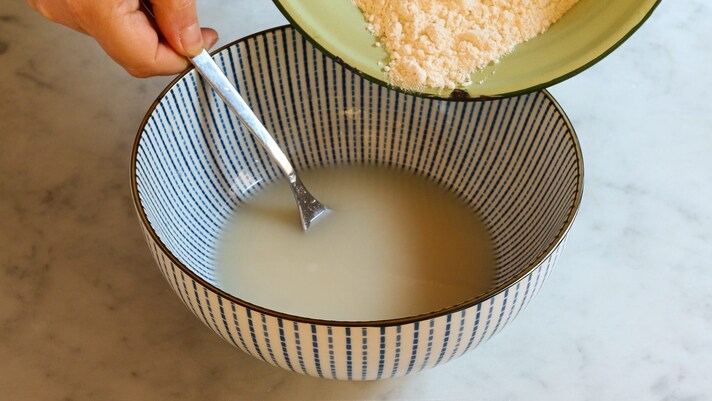
Dissolve the yeast and sugar in the water, then add the flour.
Dissolve the yeast and sugar in the water, then add the flour.
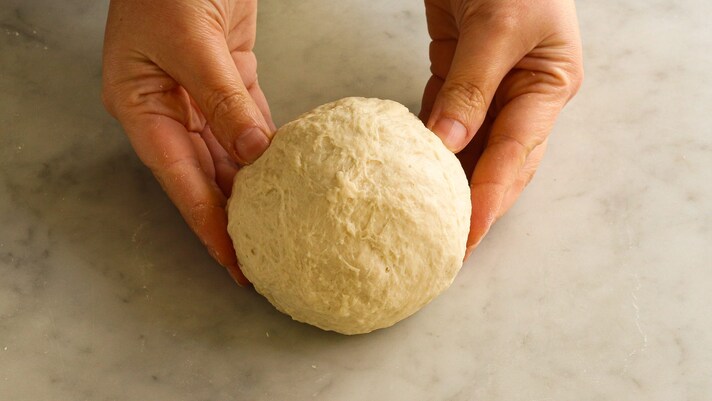
Add the oil and salt, then knead vigorously until you get a smooth and compact dough.
Add the oil and salt, then knead vigorously until you get a smooth and compact dough.
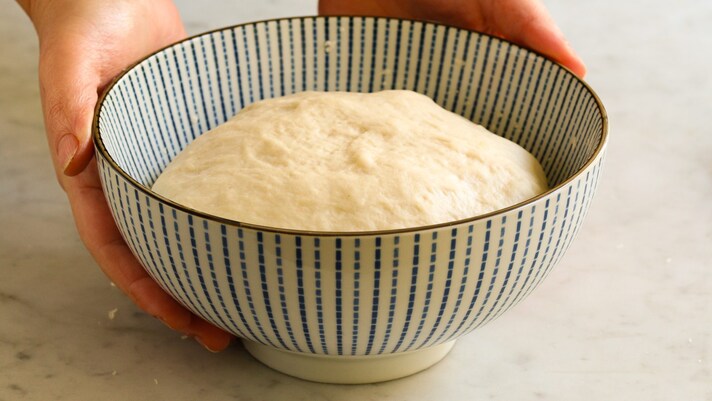
Place it in a bowl and let it rise in a warm, sheltered place until it doubles in size; depending on the temperature, it will take you about 2 hours.
Place it in a bowl and let it rise in a warm, sheltered place until it doubles in size; depending on the temperature, it will take you about 2 hours.
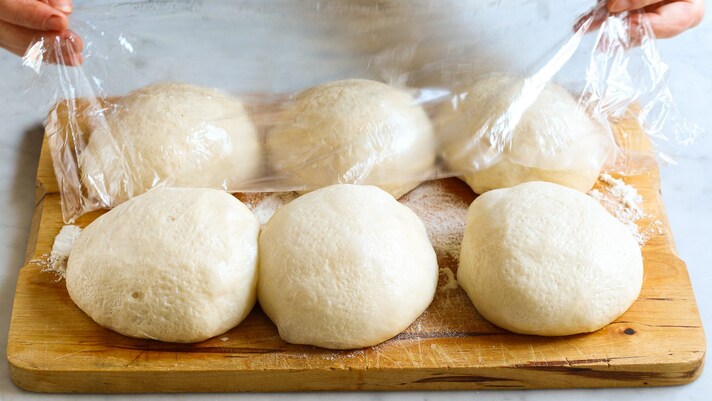
Divide the dough into 6 equal balls and leave them to rise for another 20 minutes on a lightly floured cutting board, greased with a drop of oil on the surface and covered with cling film.
Divide the dough into 6 equal balls and leave them to rise for another 20 minutes on a lightly floured cutting board, greased with a drop of oil on the surface and covered with cling film.
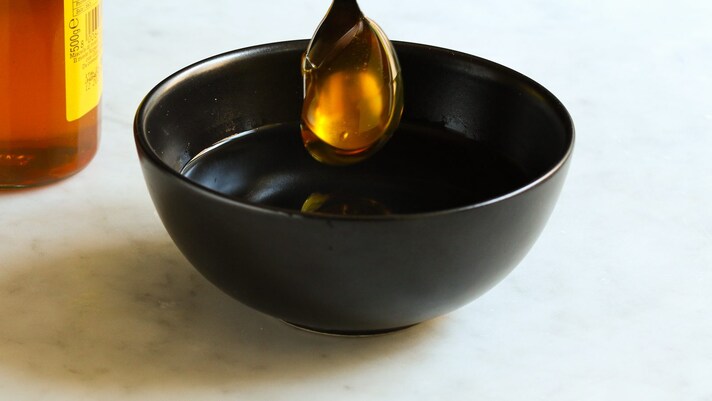
Meanwhile, prepare the syrup by mixing the honey with the warm water.
Meanwhile, prepare the syrup by mixing the honey with the warm water.
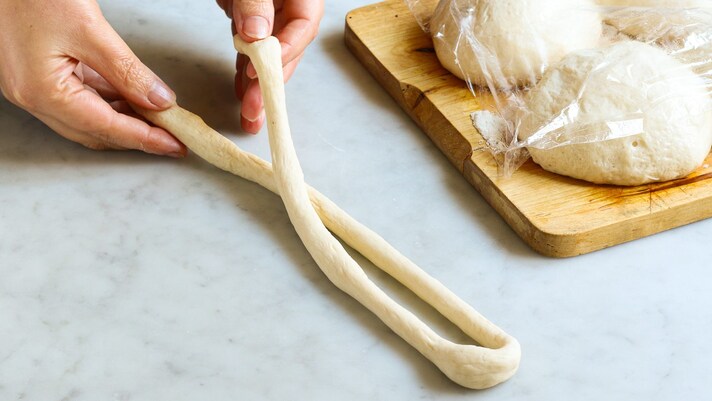
Form a long rope with each ball, then fold it into a "U" shape and start braiding the two ends over each other.
Form a long rope with each ball, then fold it into a "U" shape and start braiding the two ends over each other.
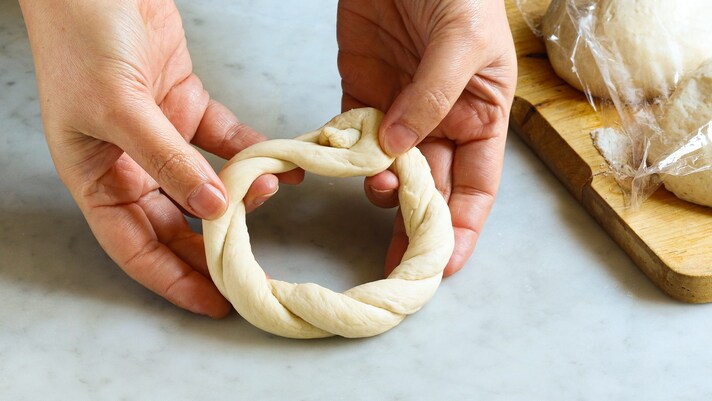
Close the braid you have obtained into a ring, sealing it well; alternatively, you can braid two shorter cords, following the same procedure, and then close them into a ring. At this point, turn on the oven and set the temperature to 480°F/250°C, so that it is already very hot when you bake the simit.
Close the braid you have obtained into a ring, sealing it well; alternatively, you can braid two shorter cords, following the same procedure, and then close them into a ring. At this point, turn on the oven and set the temperature to 480°F/250°C, so that it is already very hot when you bake the simit.
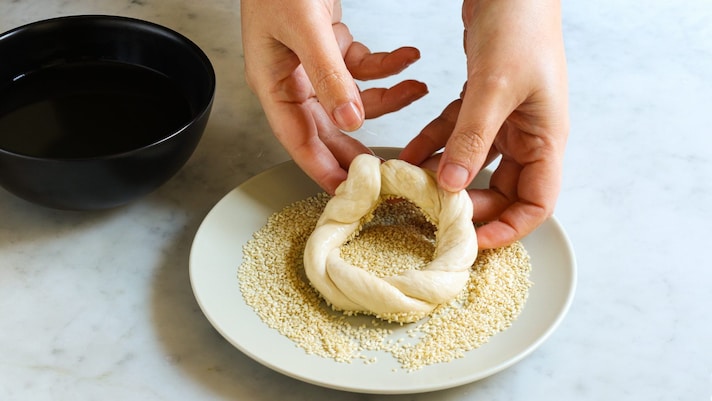
Completely immerse each donut in the honey and water syrup, then cover them with sesame seeds.
Completely immerse each donut in the honey and water syrup, then cover them with sesame seeds.
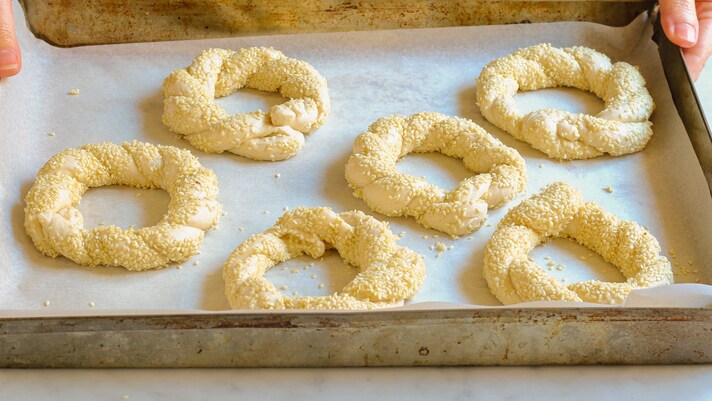
Arrange the simits on a baking tray, lined with parchment paper, well spaced apart from each other.
Arrange the simits on a baking tray, lined with parchment paper, well spaced apart from each other.
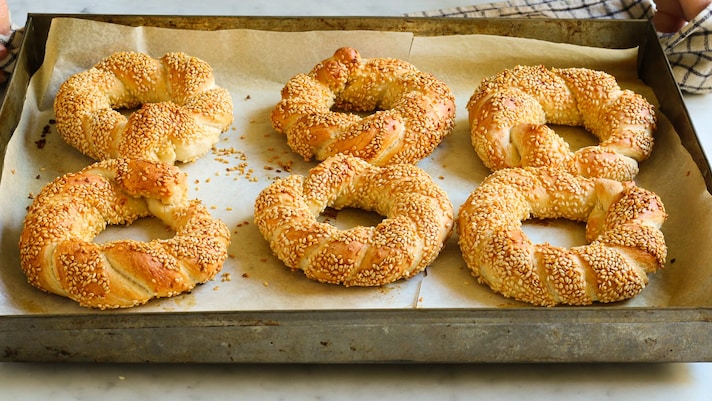
Bake in a static oven at 480°F/250°C for 10 minutes, then lower the temperature to 390°F/200°C and continue for another 20 minutes. Remove from the oven when the bread is visibly puffed up and golden, and let them cool before serving.
Bake in a static oven at 480°F/250°C for 10 minutes, then lower the temperature to 390°F/200°C and continue for another 20 minutes. Remove from the oven when the bread is visibly puffed up and golden, and let them cool before serving.

Bring Simit to the table and enjoy them in all their fragrance.
Bring Simit to the table and enjoy them in all their fragrance.
;Resize,width=767;)


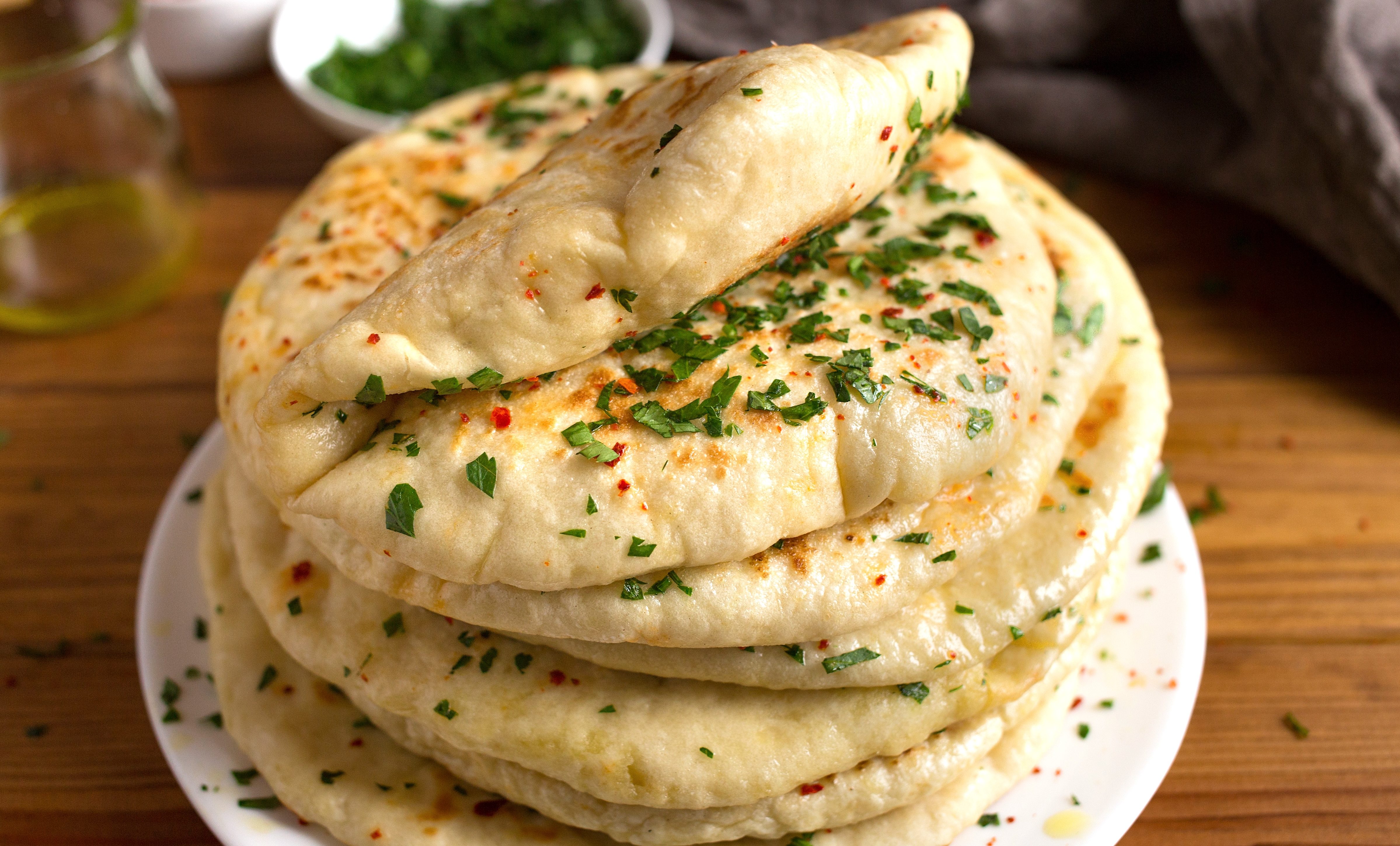;Resize,width=712;)
